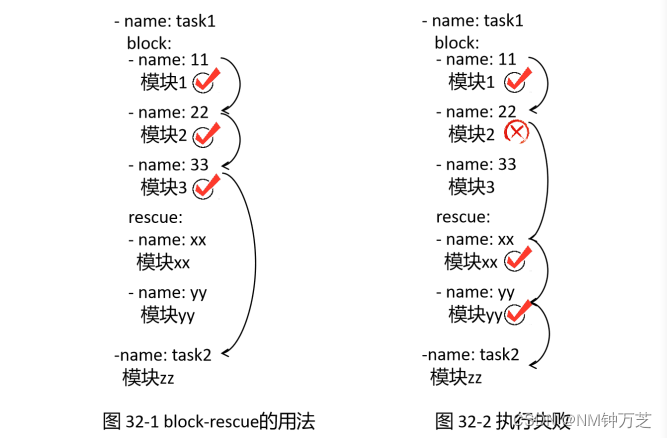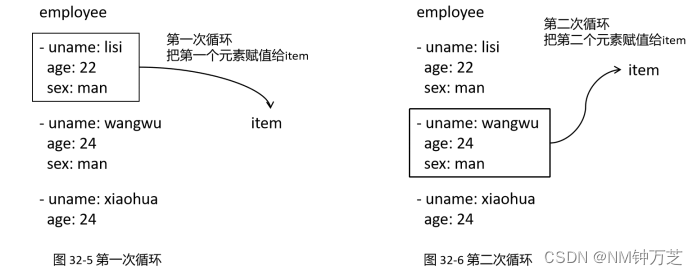linux中playbook的控制语句
发布时间:2023年12月22日
本章主要介绍 playbook中的控制语句。
- 使用 when 判断语句
- block-rescue判断
- 循环语句
一个play中可以包含多个task,如果不想所有的task全部执行,可以设置只有满足某个
条件才执行这个task,不满足条件则不执行此task。本章主要讲解when 和 block-rescue两
种判断语句。
32.1 判断语句when
when作为一个判断语句,出现在某个 task下,格式如下。
1 tasks:
2 ‐ name: aa
3 模块1
4 when: 条件1
如果条件1成立,则执行模块1,否则不执行。
注意
在when中引用变量时是不用加{{}}的。
本章实验都在/home/duan/demo3下操作,先把 demo3目录创建出来并把ansible.cfg
和 hosts拷贝进去,命令如下。
[root@pp ~]# mkdir demo3
[root@pp ~]# cp ansible.cfg hosts demo3/
[root@pp ~]# cd demo3/
[root@pp demo3]#
32.1.1 when判断中>、<、!=的使用
练习1:写一个playbook,判断某条件是否成立,成立了才执行task,否则不执行,命令
如下。
[root@pp demo3]# cat when-1.yaml
---
- hosts: up
tasks:
- name: tasks1
debug: msg="111"
when: 1<2
[root@pp demo3]#
这里有一个task,判断1<2是否成立,如果成立则执行task1,屏幕上会显示111;如果不
成立则不执行taskl,屏幕上不会显示111。这里明显是成立的,所以会执行task1。运行结
果如下。
[root@pp demo3]# ansible-playbook when-1.yaml
PLAY [up] ********************************************************************************
TASK [Gathering Facts] *******************************************************************
ok: [up]
TASK [tasks1] ****************************************************************************
ok: [up] => {
"msg": "111"
}
PLAY RECAP *******************************************************************************
up : ok=2 changed=0 unreachable=0 failed=0 skipped=0 rescued=0 ignored=0
hen后面可以有多个条件,用or或and作为连接符。
如果用or作为连接符,只要有一个条件成立即可,只有所有的条件都不成立时,整体才不成
立。
练习2:修改when-1.yaml的内容如下。
[root@pp demo3]# cat when-1.yaml
---
- hosts: up
tasks:
- name: tasks1
debug: msg="111"
when: 1<2 or 2>3
此处用or作为连接符,只要有一个条件成立就会成立,2>3不成立,但是1<2成立,所以
整体上就是成立的。运行结果如下。
[root@pp demo3]# ansible-playbook when-1.yaml
PLAY [up] ********************************************************************************
TASK [Gathering Facts] *******************************************************************
ok: [up]
TASK [tasks1] ****************************************************************************
ok: [up] => {
"msg": "111"
}
PLAY RECAP *******************************************************************************
up : ok=2 changed=0 unreachable=0 failed=0 skipped=0 rescued=0 ignored=0
常见的判断符包括以下6种。
(1)==:等于。
(2)!=:不等于。
(3)>:大于。
(4)>=:大于等于。
(5)<:小于。
(6)<=:小于等于。
练习:如果server2的系统主版本是7(RHEL/CentOS7),则打印111,否则不打印。
playbook的内容如下。
[root@pp demo3]# cat when-2.yaml
---
- hosts: up
tasks:
- name: tasks2
debug: msg="111"
when: ansible_distribution_major_version == "7"
[root@pp demo3]#
因为server2的系统是RHEL8,所以不会执行此task2,即不会显示111。
[root@pp demo3]# ansible-playbook when-2.yaml
PLAY [up] ********************************************************************************
TASK [Gathering Facts] *******************************************************************
ok: [up]
TASK [tasks2] ****************************************************************************
skipping: [up]
PLAY RECAP *******************************************************************************
up : ok=1 changed=0 unreachable=0 failed=0 skipped=1 rescued=0 ignored=0
注意
ansible_distribution major version的值是一个字符串,所以when判断中=后面的7是要加引号
的。
练习2:修改when-2.yaml 的内容如下。
[root@pp demo3]# cat when-2.yaml
---
- hosts: up
tasks:
- name: tasks2
debug: msg="111"
when: ansible_distribution_major_version == "8"
[root@pp demo3]#
再次运行此playbook,命令如下,会显示111。
[root@pp demo3]# ansible-playbook when-2.yaml
PLAY [up] ********************************************************************************
TASK [Gathering Facts] *******************************************************************
ok: [up]
TASK [tasks2] ****************************************************************************
ok: [up] => {
"msg": "111"
}
PLAY RECAP *******************************************************************************
up : ok=2 changed=0 unreachable=0 failed=0 skipped=0 rescued=0 ignored=0
[root@pp demo3]#
再次提醒:在when 中引用变量时是不用加{{}}的。
32.1.2 when判断中in的用法
在when语句中,除可以使用上面的大于、小于等判断方法外,还可以使用 in,用法如
下。
1 value in 列表
如果此值在这个列表中,则判断成立,否则不成立。
练习:判断某值是否在列表中,编写 when-3.yaml,命令如下。
[root@pp demo3]# cat when-3.yaml
---
- hosts: up
vars:
list1: [1,2,3,4]
tasks:
- name: task3
debug: msg="333"
when: 2 in list1
[root@pp demo3]#
此处定义了一个列表 list1,里面有4个值,分别为1、2、3、4;定义了一个task打印333,
会不会执行这个task,就要看when后面的判断是否成立。如果2在列表list1中,则执行;如果
不在,则不执行,很明显2在列表list1中,所以会执行此task,即屏幕上会显示333。运行结
果如下。
[root@pp demo3]# ansible-playbook when-3.yaml
PLAY [up] ********************************************************************************
TASK [Gathering Facts] *******************************************************************
ok: [up]
TASK [task3] *****************************************************************************
ok: [up] => {
"msg": "333"
}
PLAY RECAP *******************************************************************************
up : ok=2 changed=0 unreachable=0 failed=0 skipped=0 rescued=0 ignored=0
因为2在列表list1中,when判断成立,可以正确执行task3,所以屏幕上会显示333。修
改when-3.yaml的内容如下。
[root@pp demo3]# cat when-3.yaml
---
- hosts: up
vars:
list1: [1,2,3,4]
tasks:
- name: task3
debug: msg="333"
when: 2 not in list1
[root@pp demo3]#
这里判断的是2不在列表list1中,但2是在列表list1中的,所以判断不成立。运行结果如
下。
[root@pp demo3]# ansible-playbook when-3.yaml
PLAY [up] ********************************************************************************
TASK [Gathering Facts] *******************************************************************
ok: [up]
TASK [task3] *****************************************************************************
skipping: [up]
PLAY RECAP *******************************************************************************
up : ok=1 changed=0 unreachable=0 failed=0 skipped=1 rescued=0 ignored=0
[root@pp demo3]#
因为when判断不成立,所以屏幕上不会显示333。回想前面的例子。
[root@pp demo3]# cat /root/demo2/9-inventory1.yaml
---
- hosts: db
tasks:
- name: 打印我在清单文件中的名称
debug: msg={{inventory_hostname}}
when: inventory_hostname in groups ['xx']
[root@pp demo3]#
这里判断当前正在执行的主机是不是属于主机组xx,如果是则执行debug,如果不是则不执
行。
32.1.3 when判断中is的用法
is可以用于判断变量是否被定义,常见的判断包括以下3种。
(1)is defined:变量被定义。
(2)is undefined:等同于is not defined,变量没有被定义。
(3)is none:变量被定义了,但是值为空。
看下面的例子。
[root@pp demo3]# cat when-4.yaml
---
- hosts: up
vars:
aa: 1
bb:
tasks:
- name: tasks1
debug: msg="111"
when: aa is undefined
- name: tasks2
debug: msg="222"
when: bb is undefined
- name: tasks3
debug: msg="333"
when: cc is not defined
[root@pp demo3]#
首先定义了两个变量:aa和 bb,其中bb的值为空,此处并没有定义cc。后面定义了以下
3个task。
(1)如果aa被定义了,则显示111,这里aa被定义了,所以判断成立,会执行task1。
(2)如果b没有被定义,则显示222,这里bb被定义了,所以判断不成立,不会执行
task2。
(3)如果cc没有被定义,则显示333,这里cc没有被定义,所以判断成立,会执行
task3。
这里is undefined 和is not defined是一个意思。
查看运行的结果,如下所示。
[root@pp demo3]# ansible-playbook when-4.yaml
PLAY [up] ********************************************************************************
TASK [Gathering Facts] *******************************************************************
ok: [up]
TASK [tasks1] ****************************************************************************
skipping: [up]
TASK [tasks2] ****************************************************************************
skipping: [up]
TASK [tasks3] ****************************************************************************
ok: [up] => {
"msg": "333"
}
PLAY RECAP *******************************************************************************
up : ok=2 changed=0 unreachable=0 failed=0 skipped=2 rescued=0 ignored=0
32.2判断语句block-rescue
对于when来说,只能做一个判断,成立就执行,不成立就不执行。block和rescue一般
同用,类似于shell判断语句中的if-else,在block下面可以包含多个模块,来判断这多个模块
是否执行成功了。
block-rescue的用法如下。
1 block:
2 ‐ 模块1
3 ‐ 模块2
4 ‐ 模块3
5 rescue:
6 ‐ 模块1
7 ‐ 模块2
先执行 block中的模块1,如果没有报错,则继续执行模块2,如果block中的所有模块都
执行成功了,则跳过rescue 中的所有模块,直接执行下一个task中的模块,如图32-1所
示。
这里有2个task : task1和 task2,在 task1的block中有3个模块,rescue中有2个模块。
如果 block1中的所有模块都正确执行了,则不执行rescue中的模块,直接执行task2。
如果 block中的任一模块执行失败,block中其他后续的模块都不再执行,然后会跳转执行
rescue 中的模块,如图32-2所示。

这里block1中的模块1执行完成之后会执行模块2,如果模块2报错,则不会执行模块3,
直接跳转到rescue中,执行模块x。rescue中的所有模块全部正确执行完成之后,则执行
task2。
如果rescue中的某个模块执行失败,则退出整个playbook,如图32-3所示。
这里 block中的模块2执行失败,则跳转到rescue中执行模块x,如果模块x执行失败,则退
出整个 playbook,即也不会执行task2了。
如果某个报错模块有 ignore_errors: yes选项,则会忽略此模块的错误,继续执行下一个
模块,如图32-4所示。

这里block中的模块2执行失败了,但是因为加了ignore_errors: yes选项,所以会忽略这
个报错模块,继续执行模块3。
练习1:按上面的描述写一个playbook,内容如下。
[root@pp demo3]# cat block-1.yaml
---
- hosts: up
tasks:
- name: task1
block:
- name: 11
debug: msg="1111"
- name: 22
shell: "ls /aa.txt"
- name: 33
debug: msg="3333"
rescue:
- name: xx
debug: msg="xxxx"
- name: yy
debug: msg="yyyy"
- name: task2
debug: msg="zzzz"
[root@pp demo3]#
这里在task1的block中运行了3个模块,第一个模块可以正确执行,第二个模块是执行一
个系统命令ls /aa.txt,但是在server2中是不存在/aa.txt这个文件的,所以这个模块会执行
失败。block中的第三个模块不再执行,直接跳转到rescue中的模块。rescue中的2个模块均
可正确执行,然后执行task2。
所以,屏幕上会显示1111, xxxx, yyyy, zzzz。运行结果如下。
[root@pp demo3]# ansible-playbook block-1.yaml
PLAY [up] ********************************************************************************
TASK [Gathering Facts] *******************************************************************
ok: [up]
TASK [debug] *****************************************************************************
ok: [up] => {
"msg": "1111"
}
TASK [shell] *****************************************************************************
fatal: [up]: FAILED! => {"changed": true, "cmd": "ls /aa.txt", "delta": "0:00:00.009915", "end": "2023-12-22 11:38:31.526934", "msg": "non-zero return code", "rc": 2, "start": "2023-12-22 11:38:31.517019", "stderr": "ls: 无法访问'/aa.txt': 没有那个文件或目录", "stderr_lines": ["ls: 无法访问'/aa.txt': 没有那个文件或目录"], "stdout": "", "stdout_lines": []}
TASK [xx] ********************************************************************************
ok: [up] => {
"msg": "xxxx"
}
TASK [yy] ********************************************************************************
ok: [up] => {
"msg": "yyyy"
}
TASK [task2] *****************************************************************************
ok: [up] => {
"msg": "zzzz"
}
PLAY RECAP *******************************************************************************
up : ok=5 changed=0 unreachable=0 failed=0 skipped=0 rescued=1 ignored=0
32.3 循环语句
在shell中 for循环的用法如下。
1 for i in A B C ... ; do
2 命令 $
3 done
这里首先把A赋值给i,执行do和done之间的命令;然后把B赋值给i,执行do和 done之间
的命令,以此类推,直到把in后面所有的值执行完毕。for后面的变量可以随便命名。
再回顾一下前面介绍的列表,如下所示。
1 employee:
2 ‐ uname: lisi
3 age: 22
4 sex: man
5
6 ‐ uname: wangwu
7 age: 24
8 sex: man
9
10 ‐ uname: xiaohua
11 age: 21
这里列表employee中有3个元素,分别记录了lisi、wangwu、xiaohua的信息。我们把
这3个元素当成刚讲的for循环中的A、B、C。先把第一个元素赋值给变量,执行某个操作,
完成之后再把第二个元素赋值给变量。
用for循环A、B、C,在playbook中用loop来循环列表中的元素。在for循环中,指定一个
变量如i,然后分别把A、B、C赋值给i。
在loop中,使用一个固定的变量 item,然后把每个元素赋值给item,如图32-5所示。第
二次循环,如图32-6所示。

练习1:定义一个列表users,然后循环这个列表中的每个元素,命令如下。
[root@pp demo3]# cat loop-1.yaml
---
- hosts: up
vars:
users:
- uname: tom
age: 20
sex: man
- uname: bob
age: 22
sex: man
- uname: mary
age: 20
sex: woman
tasks:
- name: task1
debug: msg={{ item }}
loop: "{{ users }}"
[root@pp demo3]#
这里定义了一个列表users,里面包含了3个用户的信息,在taskl中用loop开始循环这个
列表。loop后面写列表名时,需要使用引号引起来,这里的关键字loop可以换成关键字
with_items.
这里首先把users的第一个元素赋值给item,用debug 打印;然后把users的第二个元素赋
值给item,用 debug打印,直到把所有的元素都赋值给 item。
运行此 playbook,命令如下。
[root@pp demo3]# ansible-playbook loop-1.yaml
PLAY [up] ********************************************************************************
TASK [Gathering Facts] *******************************************************************
ok: [up]
TASK [task1] *****************************************************************************
ok: [up] => (item={'uname': 'tom', 'age': 20, 'sex': 'man'}) => {
"msg": {
"age": 20,
"sex": "man",
"uname": "tom"
}
}
ok: [up] => (item={'uname': 'bob', 'age': 22, 'sex': 'man'}) => {
"msg": {
"age": 22,
"sex": "man",
"uname": "bob"
}
}
ok: [up] => (item={'uname': 'mary', 'age': 20, 'sex': 'woman'}) => {
"msg": {
"age": 20,
"sex": "woman",
"uname": "mary"
}
}
PLAY RECAP *******************************************************************************
up : ok=2 changed=0 unreachable=0 failed=0 skipped=0 rescued=0 ignored=0
练习2:修改loop-1.yaml的内容如下。
[root@pp demo3]# cat loop-1.yaml
---
- hosts: up
vars:
users:
- uname: tom
age: 20
sex: man
- uname: bob
age: 22
sex: man
- uname: mary
age: 20
sex: woman
tasks:
- name: task1
debug: msg={{ item.uname }}
loop: "{{ users }}"
[root@pp demo3]#
列表的每个元素都是一个字典,所以 item就是字典,要获取这个字典中的uname变量,用
item.uname即可。
运行此 playbook,命令如下。
[root@pp demo3]# ansible-playbook loop-1.yaml
PLAY [up] ********************************************************************************
TASK [Gathering Facts] *******************************************************************
ok: [up]
TASK [task1] *****************************************************************************
ok: [up] => (item={'uname': 'tom', 'age': 20, 'sex': 'man'}) => {
"msg": "tom"
}
ok: [up] => (item={'uname': 'bob', 'age': 22, 'sex': 'man'}) => {
"msg": "bob"
}
ok: [up] => (item={'uname': 'mary', 'age': 20, 'sex': 'woman'}) => {
"msg": "mary"
}
PLAY RECAP *******************************************************************************
up : ok=2 changed=0 unreachable=0 failed=0 skipped=0 rescued=0 ignored=0
练习3:如果想打印所有性别为男的那些用户名,修改loop-1.yaml 的内容如下。
[root@pp demo3]# cat loop-1.yaml
---
- hosts: up
vars:
users:
- uname: tom
age: 20
sex: man
- uname: bob
age: 22
sex: man
- uname: mary
age: 20
sex: woman
tasks:
- name: task1
debug: msg={{ item.uname }}
when: item.sex == "man"
loop: "{{ users }}"
[root@pp demo3]#
在此playbook中,我们用when加了一个判断。循环列表时,首先把第一个元素赋值给
item,然后判断item.sex的值是否为man,如果是则判断成立,执行debug模块;如果不是
则判断不成立,不执行debug模块。
第一次循环结束之后,开始第二次循环,把第二个元素赋值给item之后,做相同的判
断。运行此 playbook,命令如下。
[root@pp demo3]# ansible-playbook loop-1.yaml
PLAY [up] ********************************************************************************
TASK [Gathering Facts] *******************************************************************
ok: [up]
TASK [task1] *****************************************************************************
ok: [up] => (item={'uname': 'tom', 'age': 20, 'sex': 'man'}) => {
"msg": "tom"
}
ok: [up] => (item={'uname': 'bob', 'age': 22, 'sex': 'man'}) => {
"msg": "bob"
}
skipping: [up] => (item={'uname': 'mary', 'age': 20, 'sex': 'woman'})
PLAY RECAP *******************************************************************************
up : ok=2 changed=0 unreachable=0 failed=0 skipped=0 rescued=0 ignored=0
[root@pp demo3]#
这样就把所有性别为男的用户名打印出来了。
文章来源:https://blog.csdn.net/ZXDNM_zwz/article/details/135146642
本文来自互联网用户投稿,该文观点仅代表作者本人,不代表本站立场。本站仅提供信息存储空间服务,不拥有所有权,不承担相关法律责任。 如若内容造成侵权/违法违规/事实不符,请联系我的编程经验分享网邮箱:chenni525@qq.com进行投诉反馈,一经查实,立即删除!
本文来自互联网用户投稿,该文观点仅代表作者本人,不代表本站立场。本站仅提供信息存储空间服务,不拥有所有权,不承担相关法律责任。 如若内容造成侵权/违法违规/事实不符,请联系我的编程经验分享网邮箱:chenni525@qq.com进行投诉反馈,一经查实,立即删除!
最新文章
- Python教程
- 深入理解 MySQL 中的 HAVING 关键字和聚合函数
- Qt之QChar编码(1)
- MyBatis入门基础篇
- 用Python脚本实现FFmpeg批量转换
- python|写一个简单的http服务器
- Java-基于okhttp请求SSE接口流式返回
- 黑客技术(网络安全)自学1.0
- Python第四章
- Linux查看物理内存信息
- 《MyBatis》--多数据源使用实现--超级详细!!!!
- 使用 Go 语言统计 0-200000 的数字中,哪些是素数?
- java中: idea如何配置运行快捷键?
- Flutter实现windows应用版本升级功能
- 从零实现一套低代码(保姆级教程) --- 【14】实现头像组件和徽标容器